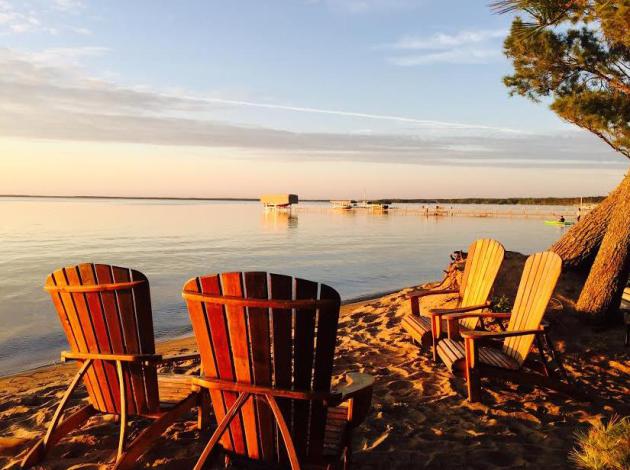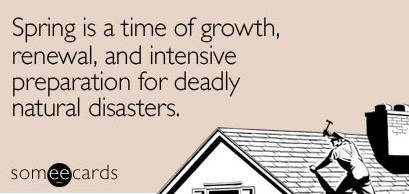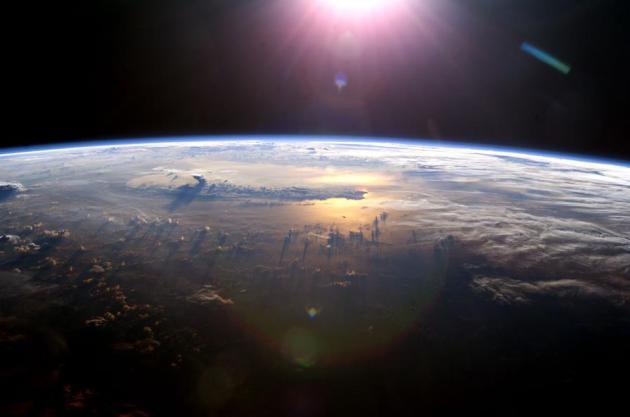April 30, 2004: After a high temperature of 91 on the previous day in the Twin Cities, the mercury tumbles to 47 degrees by the morning. St. Cloud sheds 50 degrees over 12 hours.
April 30, 1967: Tornadoes hit southern Minnesota. Some of the towns affected were Albert Lea, Waseca, Wells, and Owatonna.

Counting Up Our Atmospheric Blessings
You may want to call a friend in Denver to chat about the weather. The Mile High City may see half a foot of slush today and tonight. Today’s weather blog includes a story of early warmth sparking an early outbreak of scorpions in Arizona. Remind me not to complain about last week’s cool temperatures.
After a fairly tame, Peoria winter, warmth has put spring planting on fast forward. According to Mark Seeley “Minnesota farmers accomplished the earliest-ever planting of sugar beets, and a very early planting of corn, with over half of the 7 million acre crop planted by the last week of April.” We have very little to complain about in the weather department.
But give it time.
The sun gets tangled up in high clouds today; the next southern storm pushing rain into far southern Minnesota by evening. I see a dry streak for most of the state today into next Saturday, when temperatures may approach 80F. Expect 60s and a few 70s next week with a shower risk on Wednesday. And it’s still too cool and dry for anything severe.
Enjoy a serene weather honeymoon; some of the best weather of 2016 is on the way.
70s by Tuesday. Another wave of spring fever is imminent, I fear. Model guidance shows a steady warming trend into the middle of next week; most simulations pulling temperatures into the 70s by Tuesday. Graphic: Aeris Enterprise.
80s Second Week of May? A true taste of summer may be 1-2 weeks away. NOAA’s GFS model predicts highs consistently in the 8s between May 10 and May 14. Circle your calendars.

Meteorological Spring Precipitation Departures from Average. No sign of emerging drought patterns, at least not yet. Our soaking earlier in the week came at a good time. Since March 1 rainfall is a little above average in the MSP metro, significantly wetter closer to Duluth.
Warm Signal Continues. El Nino is weakening rapidly, but a warm signal remains. Since March 1 temperatures are about 4F warmer than average in the Twin Cities, factoring in an abnormally mild March. April is about 1F warmer than average for KMSP, to date.
Supersized Growing Season for Minnesota Farmers. Here are a couple of timely, relevant nuggets in this week’s installment of Mark Seeley’s Minnesota WeatherTalk: “…A brief tornado touchdown occurred in Faribault County on April 24th near Bricelyn with no reported damage. As a result of no snow cover, absence of soil frost, and warm temperatures during mid-month Minnesota farmers accomplished earliest-ever planting of sugar beets, and a very early planting of corn, with over half of the 7 million acre crop planted by the last week of April…”
IRI ENSO Forecast. Models show a rapid transition from El Nino warm phase to a (weak) La Nina cooling phase in the Pacific in the months to come. Here’s an excerpt of an explanation at the International Research Institute for Climate and Society: “…The first plot (above) shows the ensemble mean predictions of each of the individual models, and also the average of the individual model predictions (the NMME). Here, the NMME average is not weighted by the number of ensemble members in the individual models. This plot is intended to provide some idea of the disagreement among the individual models. Corrections for systematic biases are not done. Predictions of ENSO are probabilistic. The ensemble mean prediction it is only a best single guess. On either side of that prediction, there is a substantial uncertainty distribution, or error tolerance…”
January 22-23, 2016 Blizzard Now Thought To Be Biggest Snowfall on Record for New York City. Nearly 18″ fell in Washington D.C. – for NYC it was a legitimate record-setter. Here’s an excerpt of a review from NOAA: “…The preliminary Central Park measurement will be adjusted upward to 27.5 inches, which will become an all-time snowfall record for New York City when certified by NOAA’s National Centers for Environmental Information. A communication error between the weather forecast office in Upton, New York, and the Central Park Conservancy, which volunteers to take official snow measurements in Central Park, led to an inaccurate preliminary total of 26.8 inches. The snow team found the mistake when reviewing the Conservancy’s logbook…”
Nothing to Sneeze At: More CO2 = More Pollen. Here’s an excerpt of a story at Climate Central: “…In a previous report, we illustrated how ragweed pollen production increases with CO2 levels. New research continues to shed light on the relationship between pollen and climate change. While ragweed studies give one example of how pollen is impacted by higher levels of CO2, other plants have also been subsequently examined. In this report, we highlight a new study that looks at Timothy Grass pollen, a major cause of allergies during the early summer. Researchers investigated the amount of pollen produced at CO2 concentrations of 400 ppm, which is near current levels, and 800 ppm, which we would pass before the end of the century if current emissions trends continue. Not surprisingly, the grass produced about twice as much pollen at 800 ppm…”
Six Maps That Will Make You Rethink The World. I love maps, always have, but there are new maps that put challenges and opportunities into new perspective. Here’s an excerpt of a fascinating story at The Washington Post: “…The world has four significant maritime choke points, three of which are geopolitically sensitive — the Suez Canal, the Strait of Hormuz and the Strait of Malacca. We have feared for 100 years that there could be an act of terrorism or war that would block one of these choke points and disrupt global trade and energy flows. But Arctic shipping is a faster and better system. Tragic as climate change is, it opens up these new passageways to Europe, to North America, into the Hudson Bay. So the way into the heart of North America may eventually be these Arctic shipping routes…”
Map credit above: “Parag Khanna, “Connectography: Mapping the Future of Global Civilization“

The U.S. Oil and Gas Boom Is Having Global Atmospheric Consequences, Scientists Suggest. Methane is 25-100 times more potent than CO2 in retaining heat in the lower atmosphere. Here’s a clip from The Washington Post: “Scientists say they have made a startling discovery about the link between domestic oil and gas development and the world’s levels of atmospheric methane — a carbon compound that can both damage air quality and contribute to climate change. A new study in the journal Geophysical Research Letters has revealed that the Bakken Shale formation, a region of intensely increasing recent oil production centered in North Dakota and Montana, accounts for about 2 percent of the entire world’s methane output — and, in fact, may be partly responsible for reversing a decades-long decline in global methane emissions…” (File photo: Dylan Lovan, AP).
Ford Plans Long-Range Electric Car to Compate With Tesla, GM. Bloomberg reports: “Ford Motor Co. plans to introduce a long-range electric vehicle to compete with battery-powered models coming from Tesla Motors Inc. and General Motors Co. that would go 200 miles or more on a charge. “We want to make sure that we’re either among the leaders or in a leadership position,” Chief Executive Officer Mark Fields told analysts and reporters on a conference call Thursday. “When you look at some of the competitors and what they’ve announced, clearly, that’s something we’re developing for.” He didn’t say when Ford would start producing the vehicle...”


SUNDAY: Partly sunny and pleasant. Winds: NE 10-15. High: 61
MONDAY: Blue sky, light winds. Perfect. Winds: W 5-10. Wake-up: 40. High: 66
TUESDAY: Plenty of sun. Distractingly nice. Winds: W 10-20. Wake-up: 46. High: 72
WEDNESDAY: More clouds, instability shower? Winds: N 8-13. Wake-up: 49. High: 63
THURSDAY: Sunnier and milder. Clock out early. Winds: SW 8-13. Wake-up: 44. High: 70
FRIDAY: As good as it gets. Still sunny. Wake-up: 47. High: 74
Climate Stories…

The Top 10 Reasons to be Hopeful on Climate Change. Thanks to Jeff Masters at WunderBlog for an uplifting post; here’s an excerpt: “…My favorite talk today: “Barrier Busting: Leapfrogging Zombie Science Arguments to Get to Solutions,” by my favorite communications expert, Susan Hassol of climatecommunication.org. She argued that emphasizing the solutions to climate change rather than talking about the science, is a better way to communicate to the public. Talking about the science of climate change often leads to confusion, due to long-discredited arguments by climate change deniers that rise from the dead like zombies. But people are very supportive of actions to take action on climate change, regardless of their views on the science. For example, 72% of Republicans and 68% of conservative Republicans support efforts to develop clean energy, even though far fewer than half of them believe that the climate is warming and humans are responsible. Susan presented her top list of reasons to be hopeful about climate change:
10) President Obama has put climate change at the top of his agenda.
9) The Pope has framed climate change as a moral issue.
8) China has become highly motivated and engaged, and naysayers can no longer claim that we shouldn’t do anything because China is not...”
Syria and Climate Change: Did The Media Get It Right? Can you connect the dots with a high degree of confidence? Did the worst drought in 800 years have a clear climate-related signal, and how did this fan the flames of civil war? Here’s an overview of an in-depth report from The Climate and Migration Coalition: “During 2015 the media started connecting climate change with the conflict in Syria and subsequent refugee movements across Europe. Many reports were in direct response to new research making this connection. Other reports mentioned this research while examining other major events such as the drownings in the Mediterranean, the refugee camp in Calais and the terrorist attacks in November 2015. But did those media reports accurately represent the research they referenced?..”
Greenland Ice Sheet Melting Has Started Early. Here’s a snippet of a report at The Sydney Morning Herald: “…Greenland is really the big show when it comes to ice melt,” said Matt King, Professor of Polar Geodesy and an ARC Future Fellow at the University of Tasmania. “It’s probably losing as much ice as all the small glaciers around the world combined, and probably more than Antarctica. “Greenland is being eaten away from away from above and from the edges.” Arctic air temperatures have risen about two degrees since the 1960s. Ocean temperatures are also warming, thawing Greenland glaciers in contact with surrounding seas. Since satellite records date only from the 1970s, some natural fluctuations may be in play, he said. Still, Greenland’s early April warmth was consistent with other signals of a warming planet…”
I’m Ready to Evangelize…About Climate Change. Here’s an excerpt of a powerful Op-Ed from Jayce Hafner at Sojourners: “I’m a Christian, but I’m not a natural evangelizer. Talking about my faith has never come easily to me, and I prefer to quietly live my beliefs rather than speak about them. Even as a legislative advocate for the Episcopal Church, I am more at ease discussing policy ramifications than quoting scripture. Still, one urgent policy issue in particular has forced me to reconsider my distate for religious language and challenged me to voice my faith. Galvanized by the urgency of this challenge, I’m ready to evangelize about climate change….”
We’re Over Being Bummed About Climate Change and Ready for Solutions. Amen to that. Here’s an excerpt of an encouraging blog post at NASA: “…Look, I know it’s really hard to be optimistic when you’re down. So the best antidote to fight off the climate blues, according to Hassol, is to take action. “I do more work, give more talks, work with more scientists, get out there, and give people real hope. I also balance my reading,” she continued. “For every couple of articles I read in science journals about the melting poles, the hottest year on record, the worst fire season on record, the flooding, I try to look at what’s happening on the solutions side: the growth in solar and wind, the improvements in the economics of renewable energy, the ambitious action taking place in cities, states and countries around the world…”
Talking about my faith has never come easily to me, and I prefer to quietly live my beliefs rather than speak about them. Even as a legislative advocate for the Episcopal Church, I am more at ease discussing policy ramifications than quoting scripture.
Still, one urgent policy issue in particular has forced me to reconsider my distaste for religious language and challenged me to voice my faith. Galvanized by the urgency of this challenge, I’m ready to evangelize about climate change.
– See more at: https://sojo.net/articles/im-ready-evangelize-about-climate-change#sthash.LfP2JBnU.dpuf

How Climate Deniers Try to Sow Confusion. It didn’t work with tobacco and smoking – it won’t work with climate change. Here’s an excerpt from TIME: “…It’s not an easy time to practice climate denialism. When nearly every sentient scientist on the planet agrees that climate change is a global threat and 175 countries sign an agreement to curb it, you’re going to feel awfully lonely when the best you’ve got on your side is a U.S. Senator who brought a snowball onto the floor of the upper chamber as proof that the Earth can’t be warming, plus a lot of online friends with names like @WeaselFeet23 (sorry, Dr. @WeaselFeet23) who publish their scientific arguments 140 characters at a time….”
Climate Change and the Conservative Republican. Here’s a clip from an update at Insurance Journal: “If you’re a conservative Republican, there’s a decent chance that you believe in climate change. Compared with two years ago that is. Don’t tell this to Rush Limbaugh or presidential hopeful Donald Trump. Although he seems to have warmed a tad to the idea of a changing climate lately, Trump has been known for poking fun at believers in myriad tweets, including one in 2012 stating: “The concept of global warming was created by and for the Chinese in order to make U.S. manufacturing non-competitive.” A poll out this week from the Yale Program and Climate Change Communication states that conservative Republicans have experienced the largest shift in climate change believership of any political group with an increase of 19 percentage points over the past two years…”
Copenhagen Set To Divest from Fossil Fuels. Here’s the intro to a story at The Guardian: “Copenhagen’s mayor has announced plans to divest the city’s 6.9bn kroner (£700m) investment fund of all holdings in coal, oil and gas. If his proposal is approved at a finance committee meeting next Tuesday, as expected, the Danish capital will become the country’s first investment fund to sell its stocks and bonds in fossil fuels. “Copenhagen is at the forefront of world cities in the green transition, and we are working hard to become the world’s first CO2 neutral capital in 2025. Therefore it seems totally wrong for the municipality to still be investing in oil, coal and gas…”
Scientists Way of Fort Lauderdale’s Proposed Seawall to Combat Sea-Level Rise. How high do you want to make that wall? Here’s a clip from New Times Broward-Palm Beach: “…So, earlier this month, city officials introduced a new ordinance that would require every seawall in the city to be raised at least eight inches — but no more than 12 inches. This has some sea-level-rise experts scratching their heads, because raising the walls just inches will not protect properties for long: By 2045, sea level is anticipated to rise at least a foot, and as much as two feet by 2060…”
Photo credit above: “Sea level rise experts think the city’s plan to raise seawalls won’t be enough.” Photo by Dave via Flickr Creative Commons.
Climate Change Could Threaten Trillions of Dollars of Financial Assets, a New Study Reports. Here’s the intro to a story at PRI, Public Radio International: “New research from the London School of Economics estimates that a broad range of global stocks and other financial assets are overvalued because investment managers don’t take the risks of climate change into account. The LSE research estimates financial assets worldwide are presently overvalued by $2.5 trillion — and, in the worst case, $24 trillion. Massive climate-related writedowns are not far off in the future, which would mean huge losses for investors who ignore the risks, says Alex Bowen of the Grantham Research Institute on Climate Change at LSE and co-author of the new study, published in Nature Climate Change...”
Photo credit above: “Coastal real estate in cities like Miami are one type of asset that may be dangerously overvalued, if climate change proceeds as scientists predict.” Credit: Daniel Chudosov/Flickr.

Half of U.S. Conservatives Say Climate Change is Real. The ship is turning, as the symptoms of a rapidly warming climate become harder to dismiss or deny. Here’s a clip from Bloomberg: “The percentage of conservative Republicans who consider global warming a threat shot up 19 points in two years, to 47 percent, according to public opinion researchers at Yale University and George Mason University. Overall, 56 percent of Republicans agree that it’s happening. Including Democrats and independents, the national average for the U.S. is 73 percent. The new survey results, “Politics & Global Warming 2016,” suggest a growing gap between what most registered Republican voters understand to be true and what the party leadership says it believes, particularly on the presidential campaign trail this year…”
Politics and Global Warming, Spring 2016. Here’s an excerpt from Yale Program on Climate Change Communication that got my attention:
- An increasing number of registered voters think global warming is happening. Three in four (73%, up 7 points since Spring 2014) now think it is happening. Large majorities of Democrats—liberal (95%) and moderate/conservative (80%)—think it is happening, as do three in four Independents (74%, up 15 points since Spring 2014) and the majority of liberal/moderate Republicans (71%, up 10 points).
- By contrast, only 47% of conservative Republicans think global warming is happening. Importantly, however, there has been a large increase in the number of conservative Republicans who think global warming is happening. In fact, conservative Republicans have experienced the largest shift of any group—an increase of 19 percentage points over the past two years….
Q&A: A Canadian Evangelical Confronts U.S. Climate Politics. Here is a good summary and terrific interview transcript with one of my personal heroes, climate scientist Katherine Hayhoe, who recently visited Minnesota – courtesy of Midwest Energy News: “…It is not politically acceptable to say that climate change is a problem but we don’t want to do anything about it. But it is politically acceptable to say, it’s going to cost too much and I care about other things. It’s acceptable to say the science isn’t settled. It is definitely acceptable to say an all-powerful sovereign God would never let this happen. These are very acceptable statements in the United States in 2016...”
File photo credit: “Climate scientist Katharine Hayhoe speaks at Hardin-Simmons University in Texas in 2012.”

Catholic Bishops: “Confronting Climate Change is our Moral Obligation. As tempting as it is to look away or change the subject, as people of faith we (all) have a duty to pay attention and be part of the solution. Here’s a snippet from TheHill: “…Climate change threatens all life—and the life cycle of the earth itself. Climate change attacks the human dignity of those most affected, with the least fortunate bearing a disproportionate burden from its impacts. What the scientific consensus tells us, and what real observations and experiences around the world have shown us, is that humanity’s current reliance on fossil fuels is altering the atmosphere. Warmer oceans and higher temperatures are already being connected with increased sea levels, storm surges, rainfall intensities and droughts, as well as disruptions in growing seasons and migratory patterns. In Laudato Sí, Pope Francis highlighted the urgency of our task: “Technology based on the use of highly polluting fossil fuels – especially coal, but also oil and, to a lesser degree, gas – needs to be progressively replaced without delay.” We have a moral obligation to reduce carbon pollution, to protect people from climate impacts and to safeguard human health…”
The Clean Energy Revolution. If we jump-start and empower the markets we might just need less regulation to have the (growing) economy we all want – without the unpleasant side-effects. Here’s a clip from Foreign Affairs: “…But without major advances in clean energy technology, the Paris agreement might lead countries to offer only modest improvements in their future climate plans. That will not be enough. Even if they fulfill their existing pledges, the earth will likely warm by some 2.7 to 3.5 degrees Celsius—risking planetary catastrophe. And cutting emissions much more is a political nonstarter, especially in developing countries such as India, where policymakers must choose between powering economic growth and phasing out dirty fossil fuels. As long as this tradeoff persists, diplomats will come to climate conferences with their hands tied...”
Republican Donor Backs Clean Energy Senators with Digital Campaign. Here’s an excerpt from Reuters that left me encouraged: “A Republican political donor said on Wednesday he would spend “seven figures” on a targeted digital campaign backing two senators who support clean energy policies, which could help tip the balance in their tight November re-election races. Jay Faison, a Charlotte, North Carolina-based executive of an audio-vision equipment company, said he would endorse Republican Senator Rob Portman of Ohio and Senator Kelly Ayotte of New Hampshire for re-election. Portman is a co-sponsor of a bipartisan energy efficiency bill, while Ayotte is one of the only Republican supporters of President Barack Obama’s plan to cut carbon emissions...” (File photo: Charlotte Observer).


